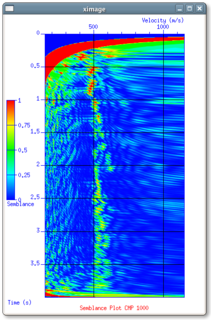
Seismology is the scientific study of earthquakes and the propagation of elastic waves through the Earth or through other planet-like bodies. The field also includes studies of earthquake environmental effects such as tsunamis as well as diverse seismic sources such as volcanic, tectonic, oceanic, atmospheric, and artificial processes such as explosions. A related field that uses geology to infer information regarding past earthquakes is paleoseismology. A recording of earth motion as a function of time is called a seismogram. A seismologist is a scientist who does research in seismology.
Exploration geophysics is an applied branch of geophysics, which uses physical methods, such as seismic, gravitational, magnetic, electrical and electromagnetic at the surface of the Earth to measure the physical properties of the subsurface, along with the anomalies in those properties. It is most often used to detect or infer the presence and position of economically useful geological deposits, such as ore minerals; fossil fuels and other hydrocarbons; geothermal reservoirs; and groundwater reservoirs.
Francis Muir is a former research associate at the Geophysics Department of Stanford University. Muir graduated from Oxford University in 1950 with an MA degree in mathematics.
Seismic anisotropy is a term used in seismology to describe the directional dependence of the velocity of seismic waves in a medium (rock) within the Earth.
The Jackson School of Geosciences at The University of Texas at Austin unites the Department of Geological Sciences with two research units, the Institute for Geophysics and the Bureau of Economic Geology.

The Geophysical Tomography Group was part of the Institut de Physique du Globe de Paris. During the years 1985-2000 it made developments in the domain of nonlinear fitting of seismic waveforms. The work of the group has been described as pioneering.
Geophysical imaging is a geophysical technique that investigates the subsurface. There are many different kinds of imaging techniques, all which are based on applied physics.
Seismic migration is the process by which seismic events are geometrically re-located in either space or time to the location the event occurred in the subsurface rather than the location that it was recorded at the surface, thereby creating a more accurate image of the subsurface. This process is necessary to overcome the limitations of geophysical methods imposed by areas of complex geology, such as: faults, salt bodies, folding, etc.
The Stanford School of Earth, Energy & Environmental Sciences, which changed its name from the School of Earth Sciences in February 2015, is one of three schools at Stanford awarding both graduate and undergraduate degrees. Stanford's first faculty member was a professor of geology; as such it is considered the oldest academic foundation of Stanford University. It is composed of four departments and two interdisciplinary programs. Research and teaching span a wide range of disciplines.

Seismic Unix is an open source seismic utilities package which was supported by the Center for Wave Phenomena (CWP) at the Colorado School of Mines (CSM). Currently it is supported by John Stockwell.
Computational geophysics entails rapid numerical computations that help analyses of geophysical data and observations. High-performance computing is involved, due to the size and complexity of the geophysical data to be processed. The main computing demanding tasks are 3D and 4D images building of the earth sub-surface, Modeling and Migration of complex media, Tomography and inverse problems.
John Clarence Karcher was an American geophysicist and businessman. He invented and eventually commercialized the reflection seismograph, applying for patents on this in 1919. In doing this he created the means by which most of the world's oil reserves have been discovered. In 1930 he and Eugene McDermott founded Geophysical Service Incorporated, a pioneering provider of seismic exploration services to the petroleum industry. This company later spun off what would become Texas Instruments.
Seismic inversion, in geophysics, is the process of transforming seismic reflection data into a quantitative rock-property description of a reservoir. Seismic inversion may be pre- or post-stack, deterministic, random or geostatistical; it typically includes other reservoir measurements such as well logs and cores.

Michael Schoenberg (1939–2008) was an American theoretical geophysicist noted for his fundamental contributions to the understanding of anisotropy in the real earth and its application to the determination of texture, fracture porosity, and flow properties of reservoir rocks.

Interferometry examines the general interference phenomena between pairs of signals in order to gain useful information about the subsurface. Seismic interferometry (SI) utilizes the crosscorrelation of signal pairs to reconstruct the impulse response of a given media. Papers by Keiiti Aki (1957), Géza Kunetz, and Jon Claerbout (1968) helped develop the technique for seismic applications and provided the framework upon which modern theory is based.

Seismic inversion involves the set of methods which seismologists use to infer properties through physical measurements. Surface-wave inversion is the method by which elastic properties, density, and thickness of layers in the subsurface are obtained through analysis of surface-wave dispersion. The entire inversion process requires the gathering of seismic data, the creation of dispersion curves, and finally the inference of subsurface properties.

John "Jack" Ertle Oliver was an American scientist. Oliver, who earned his PhD. at Columbia University in 1953, studied earthquakes and ultimately provided seismic evidence supporting plate tectonics. In the 1960s, Oliver and his former graduate student, Bryan Isacks, set up seismographic stations in the South Pacific to record earthquake activity, and the data collected led to the insight that part of the ocean floor was being pushed downward.









